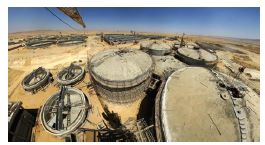Wastewater: from Waste to Resources: The Case of New Cairo, Egypt
The Arab Republic of Egypt is a water-scarce country. Most of the country is desert, with the exception of the corridor of urban development along the Nile River and Mediterranean Sea. Population growth in Egypt’s main urban areas prompted the Government of Egypt (GoE) to encourage the growth of new urban centers to alleviate overcrowding and pressure. Out of necessity, these new centers were located further away from the Nile River. The harsh environmental conditions of the location, combined with the low level of infrastructure present in these areas, have created a potential barrier to successful establishment of the new cities. One avenue to address these concerns is the rationalization of water use in the new cities, such as by recycling wastewater for use as irrigation for agriculture. The city of New Cairo was one of the newly planned urban areas. New Cairo was expected to grow from a population of 550,000 to approximately 4 million by 2026. The existing infrastructure could not support this population growth and its pressure on water supply; as a result, sanitation and untreated wastewater was being discharged directly into the river. The Egyptian government also faced pressure to reduce its public expenditures on infrastructure projects. To increase wastewater coverage and efficiency of water use and reduce public cost of the development of infrastructure, the GoE sought to build a new wastewater treatment facility involving the private sector. The facility would treat wastewater to be used in agriculture and drainage to the Nile River. These uses would allow more freshwater to be used for drinking and other uses while also reducing pollution of the river and thereby increasing public health and environmental quality. A lack of public financing options made a publicprivate partnership (PPP) structure an attractive option. Moreover, if done right, a PPP could potentially bring into the country the latest know-how and technology, ensure that the construction was made in a timely manner, increase the efficiency of the operations and lower the risks for the public sector, among other. However, at the time there were no legal or regulatory structures for handling PPP projects. Government planners faced a lack of PPP-specific laws and limited experience in dealing with PPPs. Additionally, recent failures of private provision of public services in the energy sector in Egypt made the government hesitant about this approach. To ensure that the project was a success, the GoE partnered with outside advisers to develop appropriate governance and tender processes.
